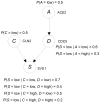A bayesian method for evaluating and discovering disease loci associations
- PMID: 21853025
- PMCID: PMC3154195
- DOI: 10.1371/journal.pone.0022075
A bayesian method for evaluating and discovering disease loci associations
Abstract
Background: A genome-wide association study (GWAS) typically involves examining representative SNPs in individuals from some population. A GWAS data set can concern a million SNPs and may soon concern billions. Researchers investigate the association of each SNP individually with a disease, and it is becoming increasingly commonplace to also analyze multi-SNP associations. Techniques for handling so many hypotheses include the Bonferroni correction and recently developed bayesian methods. These methods can encounter problems. Most importantly, they are not applicable to a complex multi-locus hypothesis which has several competing hypotheses rather than only a null hypothesis. A method that computes the posterior probability of complex hypotheses is a pressing need.
Methodology/findings: We introduce the bayesian network posterior probability (BNPP) method which addresses the difficulties. The method represents the relationship between a disease and SNPs using a directed acyclic graph (DAG) model, and computes the likelihood of such models using a bayesian network scoring criterion. The posterior probability of a hypothesis is computed based on the likelihoods of all competing hypotheses. The BNPP can not only be used to evaluate a hypothesis that has previously been discovered or suspected, but also to discover new disease loci associations. The results of experiments using simulated and real data sets are presented. Our results concerning simulated data sets indicate that the BNPP exhibits both better evaluation and discovery performance than does a p-value based method. For the real data sets, previous findings in the literature are confirmed and additional findings are found.
Conclusions/significance: We conclude that the BNPP resolves a pressing problem by providing a way to compute the posterior probability of complex multi-locus hypotheses. A researcher can use the BNPP to determine the expected utility of investigating a hypothesis further. Furthermore, we conclude that the BNPP is a promising method for discovering disease loci associations.
Conflict of interest statement
Figures









Similar articles
-
Evaluating de novo locus-disease discoveries in GWAS using the signal-to-noise ratio.AMIA Annu Symp Proc. 2011;2011:617-24. Epub 2011 Oct 22. AMIA Annu Symp Proc. 2011. PMID: 22195117 Free PMC article.
-
LEAP: biomarker inference through learning and evaluating association patterns.Genet Epidemiol. 2015 Mar;39(3):173-84. doi: 10.1002/gepi.21889. Epub 2015 Feb 12. Genet Epidemiol. 2015. PMID: 25677188 Free PMC article.
-
A method combining a random forest-based technique with the modeling of linkage disequilibrium through latent variables, to run multilocus genome-wide association studies.BMC Bioinformatics. 2018 Mar 27;19(1):106. doi: 10.1186/s12859-018-2054-0. BMC Bioinformatics. 2018. PMID: 29587628 Free PMC article.
-
Bayesian statistical methods in genetic association studies: Empirical examination of statistically non-significant Genome Wide Association Study (GWAS) meta-analyses in cancers: A systematic review.Gene. 2019 Feb 15;685:170-178. doi: 10.1016/j.gene.2018.10.057. Epub 2018 Oct 26. Gene. 2019. PMID: 30416053
-
A generalizable hypothesis for the genetic architecture of disease: pleomorphic risk loci.Hum Mol Genet. 2011 Oct 15;20(R2):R158-62. doi: 10.1093/hmg/ddr358. Epub 2011 Aug 29. Hum Mol Genet. 2011. PMID: 21875901 Free PMC article. Review.
Cited by
-
Naïve Bayesian Classifier and Genetic Risk Score for Genetic Risk Prediction of a Categorical Trait: Not so Different after all!Front Genet. 2012 Feb 29;3:26. doi: 10.3389/fgene.2012.00026. eCollection 2012. Front Genet. 2012. PMID: 22393331 Free PMC article.
-
Modeling miRNA-mRNA interactions that cause phenotypic abnormality in breast cancer patients.PLoS One. 2017 Aug 9;12(8):e0182666. doi: 10.1371/journal.pone.0182666. eCollection 2017. PLoS One. 2017. PMID: 28793339 Free PMC article.
-
Computational methods for ubiquitination site prediction using physicochemical properties of protein sequences.BMC Bioinformatics. 2016 Mar 3;17:116. doi: 10.1186/s12859-016-0959-z. BMC Bioinformatics. 2016. PMID: 26940649 Free PMC article.
-
Bayesian methods for multivariate modeling of pleiotropic SNP associations and genetic risk prediction.Front Genet. 2012 Sep 11;3:176. doi: 10.3389/fgene.2012.00176. eCollection 2012. Front Genet. 2012. PMID: 22973300 Free PMC article.
-
Evaluation of a two-stage framework for prediction using big genomic data.Brief Bioinform. 2015 Nov;16(6):912-21. doi: 10.1093/bib/bbv010. Epub 2015 Mar 18. Brief Bioinform. 2015. PMID: 25788325 Free PMC article.
References
Publication types
MeSH terms
Grants and funding
LinkOut - more resources
Full Text Sources
Other Literature Sources

